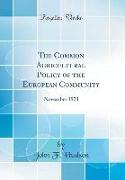The Common Agricultural Policy of the European Community
BücherAngebote / Angebote:
Excerpt from The Common Agricultural Policy of the European Community: November 1973When the European Community (ec) was established in 1958, it was apparent that a single system of farm support and protection would be necessary to create the conditions of competition that would permit trade between the member states (germany, France, Italy, Belgium, the Netherlands, and Luxembourg) to develop, and duties and restrictions between the member states to be removed. The system which the EC then devised in known as the Common Agricultural Policy (cap).In joining the EC in 1973, the United Kingdom, Denmark, and Ireland agreed to implement the cap beginning in 1973, 'and to adjust their price levels and customs charges to common levels over 5 years ending in 1978.The first cap regulations were established in 1962 and covered grains, poultry, pork, eggs, and fruit and vegetables. Regulations for beef, milk, and rice followed in 1964, fats and oils in 1966 and 1967, sugar in 1967 and 1968, and more recently tobacco, wine, hops, seeds, ¿ax, silk, and fish.The cap is perhaps most easily understood in terms of three principles: common pricing, Community preference, and common financing.Common pricing is the regulation of prices, Community-wide but not necessarily at a single level, in order to permit and promote free trade between members. No restraint is placed on production.Community preference is the organization of Community markets so that domestic products will always be cheaper than the corresponding import. The two most common devices employed to this end are minimum import prices and subsidies on domestic products.Common financing is the obligation of the Community to pay whatever is required to meet the costs of unlimited support.For two-thirds of EC production - grains, rice, sugar, olive oil, and the main animal products - common pricing and Community preference are achieved through the variable levy system. As this system Operates for grains, the market for the most important cereals is supported by government purchasing of any amount offered at fixed support, or intervention, prices. Intervention prices are set at different levels according to the producing area so that products of the main producing areas can compete equally with each other in the most deficit consuming centers - primarily Duisburg, Germany. The price at which grains can be sold at intervention in producing areas is, therefore, equal to the Duisburg price, minus freight from the given producing area. The Duisburg intervention price is set a little below the desired wholesale price for Duisburg - the target price. Imports are prevented from selling at less than the target price because imports must meet a minimum import price, or threshold price, which is equal to the Duisburg target price minus transport costs from Rotterdam. The Community observes world market price quotations for grains each day and adjusts these quotations to what they would be if they were made for grains of a standard EC quality delivered to Rotterdam. The lowest suchadjusted price for each grain is then subtracted from its threshold price. The difference is a vari able levy which is applied to all imports of the grain in question regardless of its actual price. In this way, the EC allows third countries to supply only those qualities and quantities of each grain that cannot be supplied by domestic production. The levy on August 1, 1972 (beginning of the 1972-73 marketing year), was 1 22 percent of the lowest adjusted price for wheat imports, 84 percent for corn, and comparably high for other products.About the PublisherForgotten Books publishes hundreds of thousands of rare and classic books. Find more at www.forgottenbooks.com
Folgt in ca. 10 Arbeitstagen
